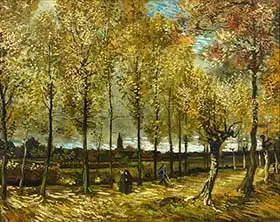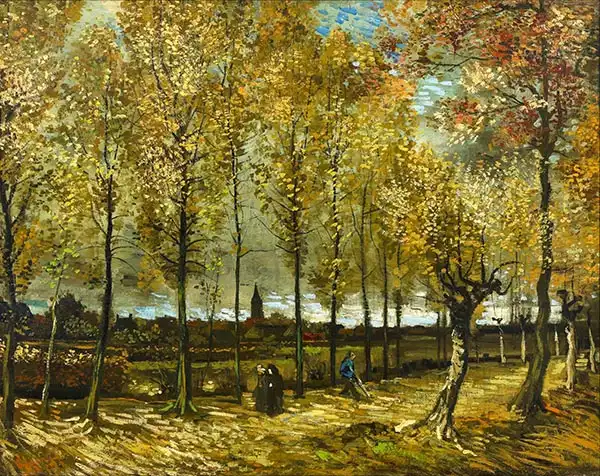About this finishing
Print. The image is printed on the top quality 10-ink HP Z9PS printer on HP matte 270 g / m2 paper. You can choose any size to an accuracy of 1 cm. A margin of 5 cm around the image is added to the size of the motif.


You can find a detailed description about our finishings
here.
Avenue of poplars
"Allee of Poplars" (originally "Allee der Pappelbäume") is an oil painting painted by the famous
Dutch painter Vincent van Gogh during his stay at the Saint-Paul-de-Mausole mental hospital in Saint-Rémy-de-Provence, France, in 1889 .This painting is one of many works by van Gogh that depict trees and nature.
The painting "Alley of poplars" shows a long avenue of trees, namely poplars, which winds along the road. The trees are placed close together and their tops intertwine, creating a shaded walkway. The image is dominated by strong vertical strokes that represent the trees and the road.
One of the characteristic elements of the painting is the use of bright colors, especially the blue sky and the yellow leaves of the trees. These colors create contrast and enhance the impression of light and warmth. Van Gogh was known for his intense and emotional style of painting, and this is evident in this painting.
"Alley of Poplars" is considered one of van Gogh's masterpieces and shows his interest in nature, light and color. This image also reflects his mental state at a time when illness and emotional instability kept him away. Van Gogh often painted nature and
landscapes during his stay in the hospital, and "Alley of Poplars" is one of the outstanding results of this creative period.
Prevailing color of this fine art print is orange and its shape is landscape. This image is printed on demand - you can choose material, size and finishing.
Vincent Willem van Gogh (1853-1890). Dutch painter belonging to
Post-Impressionism. His paintings (some 900 paintings and 1,100 drawings and sketches) are among the most famous in the world and are sold for exorbitant sums (except for those in our shop).
Parisian Impressionists He lived in Paris from 1886 and was influenced by the use of bright colours - most of his works were painted during this period. In his paintings, Gogh uses contrasting colours (often blue and orange - he said that I want to use colours other contrasts to each of them shone even more to contrast a man and a woman). He was known for his excesses and amputated an ear after the break-up of his friendship with
Gauguin. There is a lot of speculation about this incident (he possibly suffered from heavy metal poisoning from paint that had caused mental problems). In 1890, unfortunately he committed suicide.


